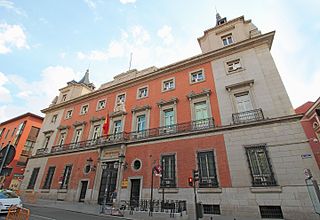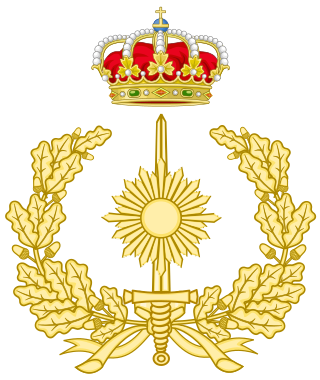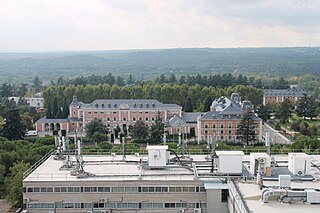
A commander-in-chief or supreme commander is the person who exercises supreme command and control over an armed force or a military branch. As a technical term, it refers to military competencies that reside in a country's executive leadership, a head of state, head of government, or other designated government official.

The Ministry of Foreign Affairs, European Union and Cooperation (MAEUEC) is a department of the Government of Spain in charge of planning, managing, carrying out and evaluating the country's foreign and international cooperation for development policies, paying special attention to the ones in relation to the European Union and Ibero-America, as well as coordinating and supervising all actions done in this areas by the other Ministries and Public Administrations. Likewise, it is responsible for promoting international economic, cultural and scientific relationships, taking part in the proposal and application of the migration policy, promoting cross-border and interterritorial cooperation, protecting Spaniards abroad and preparing, negotiating and processing the international treaties which Spain is part of.

The Ministry of Defence is the government body of the Italian Republic responsible for military and civil defence matters and managing the Italian Armed Forces. It is led by the Italian Minister of Defence, a position occupied by Guido Crosetto since October 2022.

The General Staff of the Armed Forces of the Russian Federation is the military staff of the Russian Armed Forces. It is the central organ of the military command of the Armed Forces Administration and oversees operational command of the armed forces under the Russian Ministry of Defence.

The Ministry of National Defense is the cabinet-level administrative office in charge of "maintaining the independence and sovereignty" of Chile. It is also charged with planning, directing, coordinating, executing, controlling and informing the defense policies formulated by the President of Chile. The minister supervises all the Chilean armed forces. It is Chile's ministry of defence.

The Ministry of Transport and Sustainable Mobility (MITMA), traditionally known as the Ministry of Development (MIFOM), is the department of the Government of Spain responsible for preparing and implementing the government policy on land, air and maritime transport infrastructure and the control, planning and regulation of the transport services on this areas. It is also responsible for guaranteeing access to housing; urban, soil and architecture policies; planning and controlling the postal and telegraph services, directing the services related to astronomy, geodesy, geophysics and mapping, and planning and programing the government investments on infrastructure and services related to this scope. The Ministry's headquarters are in the New Ministries government complex.

The Royal Thai Armed Forces Headquarters or the RTARF HQ, is the "mostly ornamental" joint headquarters of the Royal Thai Armed Forces, which is composed of the Royal Thai Army, the Royal Thai Navy and Royal Thai Marine Corps, and the Royal Thai Air Force. Formerly the Supreme Command Headquarters, the name was changed in February 2008. The headquarters is divided into two branches: the "Command Group" and the "Joint Group".

The Ministry of the Interior (MIR) is a department of the Government of Spain responsible for public security, the protection of the constitutional rights, the command of the law enforcement agencies, national security, immigration affairs, prisons, civil defense and road traffic safety. Through the Undersecretariat of the Interior and its superior body, the Directorate-General for Internal Policy, the Ministry is responsible for all actions related to ensuring political pluralism and the proper functioning of electoral processes.

The Ministry of Justice (MJUS) was the department of the Government of Spain responsible for preparing and carrying out the government policy in order to bring the legal system off, specially in criminal, civil, commercial and procedural law affairs, supporting the Administration of Justice and the legal and international cooperation.

The Chief of the Defence Staff is the highest-ranking military officer in the Spanish Armed Forces and is the principal military advisor to the Prime Minister, the Minister of Defence, the National Defence Council and the National Security Council. It is the fourth military authority of the country after the Monarch, the Prime Minister and the Minister of Defence because the Secretary of State for Defence and the Under-Secretary of Defence do not have military authority.
The Armed Forces Intelligence Center is a Spanish intelligence agency dependent of the Defense Staff (EMAD). It has the function of providing JEMAD, the Ministry of Defense and the Prime Minister with information on risk situations and crises from abroad. In his charge is a director with rank of general.

The Ministry of Finance or Ministry of Treasury (MH) is the department of the Government of Spain responsible for planning and carrying out the government policy on public finance and budget. It applies and manages the regional and local financing systems and the provision of information on the economic-financial activity of the different Public Administrations.

The Chief of Staff of the Army (JEME) is a military office held by a four-star general in the Spanish Army. Because of this, the JEME is the principal advisor to the Chief of the Defence Staff (JEMAD) on ground warfare and it is also an advisor to the Minister of Defence, the Secretary of State for Defence (SEDEF) and the Under-Secretary of Defence (SUBDEF).

The Defence Staff, based in Madrid, is an organ of the Ministry of Defence that operates as an auxiliary to the Chief of the Defense Staff (JEMAD) within the organic structure of the Spanish Armed Forces and in a military hierarchical position of dependence on the former.

The Integrated Defence Staff (IDS) is an organisation responsible for fostering coordination and enabling prioritisation across the different branches of the Indian Armed Forces. It is composed of representatives from the Indian Army, Indian Navy, Indian Air Force, Ministry of External Affairs, Defence Research and Development Organisation, Ministry of Defence and Ministry of Finance. The IDS is headed by Chief of Integrated Defence Staff along with Deputy Chiefs of Integrated Defence Staff. On December 24, 2019, the Cabinet Committee on Security (CCS) established the post of Chief of Defence Staff, a four-star general, a tri-service Chief, that shall lead the defence forces as well as play the role of head of the Department of Military Affairs. The body advises and assists the Chief of Defence Staff.

The Office of the Comptroller General of the Defence is a department of the Ministry of Defence of Spain that exercises the internal audit of the economic and financial management of the Ministry and of the public agencies dependent on it. Likewise, it is responsible for acting as the military notary in the form and conditions established by the laws and for advising in matters of its competence to the superior and directive departments of the Ministry. The Office is integrated in the Undersecretariat of Defence but it reports to the Comptroller General of the State.
The Directorate-General of the Civil Guard (DGGC) is a component of the Spanish Department of the Interior responsible for exercising the direct command of the Civil Guard law enforcement agency. The DGGC, integrated in the Secretariat of State for Security, is in charge of organize, direct, coordinate and execute the missions entrusted to the Civil Guard by the provisions in force, in accordance with the guidelines and orders issued by the Ministers of the Interior and of Defense, within the scope of their respective powers.
The Directorate-General for Civil Protection and Emergencies (DGPCE) is a component of the Spanish Department of the Interior responsible for promoting, planning and coordinating the various actors involved in the field of civil defence, both national and international.
Gonzalo Puigcerver Romá was a Spanish Military general of the Airforce who became the Chief of the Defense Staff in October 1986 until 1990. He is the first of air soldier of Spanish armed forces to hold the position and was appointed under the Royal Decree 2299/1986.

The Office of the Prime Minister, officially Presidency of the Government is the Spanish government structure that groups all the departments and officials that are at the service of the prime minister to fulfil its constitutional duties. It is staffed by a mix of career civil servants and advisers. The highest-ranking official within the Office is the Chief of Staff, which is a political appointment on which the rest of the Office officials depend.





















